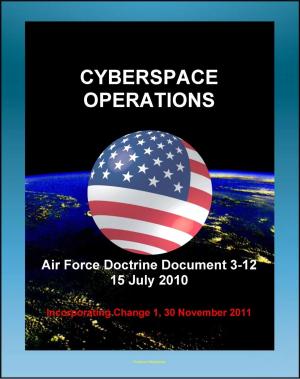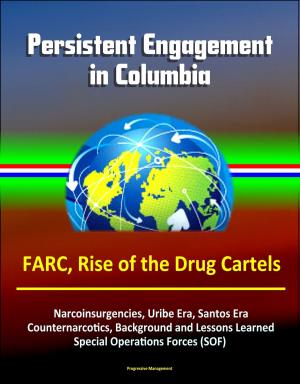The United States Air Force in Southeast Asia: Civic Action - Vietnam War, Nation Building Amid Instability, Pacification, Tet Offensive, President Kennedy, Johnson
Nonfiction, History, Military, Vietnam War, Asian, Aviation| Author: | Progressive Management | ISBN: | 9781310561498 |
| Publisher: | Progressive Management | Publication: | August 24, 2015 |
| Imprint: | Smashwords Edition | Language: | English |
| Author: | Progressive Management |
| ISBN: | 9781310561498 |
| Publisher: | Progressive Management |
| Publication: | August 24, 2015 |
| Imprint: | Smashwords Edition |
| Language: | English |
Professionally converted for accurate flowing-text e-book format reproduction, this U.S. Air Force (USAF) publication explores military civic actions in the Vietnam War. These non-military activities, although not known until recently as "military civic action," are as old as warfare itself. Nehemiah ordered ancient Israelite warriors to carry a sword in one hand and their implements to rebuild Jerusalem in the other. As early as 300 B.C. Alexander the Great created the first military engineering units, rebuilding and modernizing many conquered Persian cities. The ancient Roman legionnaire, deviating from the common practice of pillage, exploitation, and suppression of conquered peoples, built roads, located and secured cities, and dug waterways. By introducing superior Roman agricultural methods, legal system, and engineering and mining techniques, the Roman military served as a civilizing force coincidental with its military conquests.2 In more recent years, the engineering accomplishments of the British military were instrumental in transforming India and moving it into the modern era.
Capt. Betty L. Barton Christiansen, a member of the staff in the Office of Air Force History, researched and wrote this volume. She begins by establishing a framework of the civic action concept. Chapter II discusses the period corresponding to the Kennedy administration, when both government and military officials grappled with adjusting to a "new kind of war," the origins of counterinsurgency strategy (of which civic action was a part), and the efforts to apply this strategy in Vietnam. The nation-building period discussed in Chapter III, covers the period from November 1963 to July 1965, a time of great instability in South Vietnam, and the myriad efforts by the USAF to establish unity. Although he had promised to continue the policies of President Kennedy, Lyndon Johnson began to "lean away" from political and other non-military solutions to the crisis in Vietnam. This was reflected in the attitudes of the various services toward unconventional warfare and civic action. By 1966, while military solutions occupied center stage, some stability had been established in Vietnam. More attention was being paid to winning popular allegiance and USAF's Seventh Air Force formally organized its civic action activities. However, just as the program showed signs of success, the Tet offensive intervened. Thus, Chapter V demonstrates that instead of serving as advisers to the Vietnamese, the USAF civic action effort was compelled to revert to an earlier phase of its development, when humanitarian services were emphasized. Still, the program recuperated completely by July 1968. In Chapter VI, the South Vietnamese government embarked on an accelerated pacification program to extend its control throughout the country. Civic action constituted one part of this effort. Seventh Air Force sought to improve training civic action personnel, increase the number of civic action officers "in country," and obtain more resources for the program. These refinements provided a better understanding of civic action and showed the benefits of increased South Vietnamese participation. By the end of 1968, pacification had become a major part of allied strategy in Vietnam. The results of the various changes in the civic action program are discussed and assessed.
I. The Growth of a Concept * II. The Search for Definitions and Applications * III. Nation-Building Amid Instability * IV. Reviving Pacification and Civic Action Strategies * V. The Tet Offensive and Operation Recovery * VI. Program Refinement * VII. Redefining Seventh Air Force Civic Action * VIII. Summary Assessment and Conclusion
Professionally converted for accurate flowing-text e-book format reproduction, this U.S. Air Force (USAF) publication explores military civic actions in the Vietnam War. These non-military activities, although not known until recently as "military civic action," are as old as warfare itself. Nehemiah ordered ancient Israelite warriors to carry a sword in one hand and their implements to rebuild Jerusalem in the other. As early as 300 B.C. Alexander the Great created the first military engineering units, rebuilding and modernizing many conquered Persian cities. The ancient Roman legionnaire, deviating from the common practice of pillage, exploitation, and suppression of conquered peoples, built roads, located and secured cities, and dug waterways. By introducing superior Roman agricultural methods, legal system, and engineering and mining techniques, the Roman military served as a civilizing force coincidental with its military conquests.2 In more recent years, the engineering accomplishments of the British military were instrumental in transforming India and moving it into the modern era.
Capt. Betty L. Barton Christiansen, a member of the staff in the Office of Air Force History, researched and wrote this volume. She begins by establishing a framework of the civic action concept. Chapter II discusses the period corresponding to the Kennedy administration, when both government and military officials grappled with adjusting to a "new kind of war," the origins of counterinsurgency strategy (of which civic action was a part), and the efforts to apply this strategy in Vietnam. The nation-building period discussed in Chapter III, covers the period from November 1963 to July 1965, a time of great instability in South Vietnam, and the myriad efforts by the USAF to establish unity. Although he had promised to continue the policies of President Kennedy, Lyndon Johnson began to "lean away" from political and other non-military solutions to the crisis in Vietnam. This was reflected in the attitudes of the various services toward unconventional warfare and civic action. By 1966, while military solutions occupied center stage, some stability had been established in Vietnam. More attention was being paid to winning popular allegiance and USAF's Seventh Air Force formally organized its civic action activities. However, just as the program showed signs of success, the Tet offensive intervened. Thus, Chapter V demonstrates that instead of serving as advisers to the Vietnamese, the USAF civic action effort was compelled to revert to an earlier phase of its development, when humanitarian services were emphasized. Still, the program recuperated completely by July 1968. In Chapter VI, the South Vietnamese government embarked on an accelerated pacification program to extend its control throughout the country. Civic action constituted one part of this effort. Seventh Air Force sought to improve training civic action personnel, increase the number of civic action officers "in country," and obtain more resources for the program. These refinements provided a better understanding of civic action and showed the benefits of increased South Vietnamese participation. By the end of 1968, pacification had become a major part of allied strategy in Vietnam. The results of the various changes in the civic action program are discussed and assessed.
I. The Growth of a Concept * II. The Search for Definitions and Applications * III. Nation-Building Amid Instability * IV. Reviving Pacification and Civic Action Strategies * V. The Tet Offensive and Operation Recovery * VI. Program Refinement * VII. Redefining Seventh Air Force Civic Action * VIII. Summary Assessment and Conclusion















